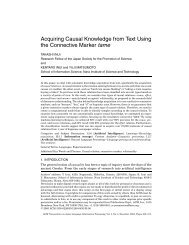2011年度 卒業論文 構成性に基づく評価極性知識獲得 - 乾・岡崎研究室
2011年度 卒業論文 構成性に基づく評価極性知識獲得 - 乾・岡崎研究室
2011年度 卒業論文 構成性に基づく評価極性知識獲得 - 乾・岡崎研究室
You also want an ePaper? Increase the reach of your titles
YUMPU automatically turns print PDFs into web optimized ePapers that Google loves.
1 1 2 32.1 ................................... 32.1.1 ................................. 32.1.2 ...................................... 42.2 ................................. 5 3 73.1 ................................... 73.2 ................................... 73.3 A B ............................... 7 4 84.1 .................................... 84.1.1 ................................ 94.1.2 ..................................... 94.1.3 .................................. 94.1.4 ....................................... 104.2 A B ................................ 10 5 125.1 .......................................... 125.2 .......................................... 125.3 .......................................... 135.3.1 ................................... 135.3.2 .................................. 13 6 [B] 156.1 B ..................... 166.2 B ................... 166.3 B A ............................... 17 7 18ii
1 Web Web () () () 3 1. 2. 2 3. 4. 3 4 2 ( A BA BA B [2]A BA B [1] A BA BB1
Web Lu [17] and but 6
4 4.1: A B [1] A BA B4.1 A B [1] 8
4.1.1 4.1 4.1.2 3 1. 2. 2. () ()4.1.3 4 3. (0) 4. (100 ) 5. (50) 6. (2) 3. (PMI) PMI(word 1 , word 2 ) = log P(word 1, word 2 )P(word 1 )P(word 2 )(4.1)9
4. () 5. 6. 4.1.4 (SVM) 3 2 4.2 A BA BA B 4.2 A B A BA B10
4.2: A B 11
55.1 () 6330 15636 3459 TSUBAKI[18] 1 1 2 1 A B 10 247 86 492 A B 10 200 224 92 621 10 117 174 838 5.2 Precision()Recall()F1 Precision =(5.1)Recall = (5.2)F1 =2 Precision RecallPrecision + Recall(5.3) () 12
5.1: A B 10 A B A B 3.16 4.91 2.81 4.75 2.60 4.17 2.38 3.81 2.34 3.64 2.19 3.57 2.15 3.43 2.14 2.95 2.11 2.94 2.06 2.405.3 5.3.1 A B 5.2 A BA B 5.1 () A B 10 A BA BA BA BRecall PrecisionShoushan [19] 5.3.2 5.3 A BA B 0.2 13
5.2: A B (P R F1) (P R F1) (P R F1)A B () .375 .621 .468 .415 .591 .487 .305 .709 .427 (A B) .201 .327 .249 .290 .329 .306 .109 .337 .165 .386 .804 .522 .315 .768 .447 .530 .851 .653 () .146 .363 .209 .164 .362 .225 .129 .366 .190 5.3: A B (P R F1) (P R F1) (P R F1) () .375 .621 .468 .415 .591 .487 .305 .709 .427 () .201 .327 .249 .290 .329 .306 .109 .337 .165 () .241 .516 .328 .289 .473 .359 .183 .516 .285 () .163 .322 .217 .220 .316 .260 .102 .337 .157A B B 14
6[B] 6.1: B A B 200 BA B 6.1 A Cpp A B B 3 1. B 2. B 3. B A 15
6.1 B B A A A B 6.1 Cpp Cnn C ppC p∗+ C nnC n∗(6.1)Cpp,Cnn 3 15 6.1 6.1: B 6.2 B A B B 6.1 C*p C*n C ∗pC ∗∗or C ∗nC ∗∗(6.2)C*p,C*n 5 15 6.3 A A 16
B () 6.2: B B () 6.3 B A A //,B 6.1 Cpn Cnp C pnC p∗+ C npC n∗(6.3)Cpn,Cnp 3 15 6.3 6.3: A 17
7A BBA BA BA BA B18
[1] . . 2008.[2] . a b. 2005.[3] V. Hatzivassiloglou and K.R. McKeown. Predicting the semantic orientation of adjectives. InProceedings of the eighth conference on European chapter of the Association for ComputationalLinguistics, pp. 174–181. Association for Computational Linguistics, 1997.[4] J. Kamps, MJ Marx, R.J. Mokken, and M. De Rijke. Using wordnet to measure semantic orientationsof adjectives. 2004.[5] M. Hu and B. Liu. Mining and summarizing customer reviews. In Proceedings of the tenth ACMSIGKDD international conference on Knowledge discovery and data mining, pp. 168–177. ACM,2004.[6] H. Takamura, T. Inui, and M. Okumura. Extracting semantic orientations of words using spinmodel. In Proceedings of the 43rd Annual Meeting on Association for Computational Linguistics,pp. 133–140. Association for Computational Linguistics, 2005.[7] A. Hassan and D. Radev. Identifying text polarity using random walks. In Proceedings of the 48thAnnual Meeting of the Association for Computational Linguistics, pp. 395–403. Association forComputational Linguistics, 2010.[8] L. Velikovich, S. Blair-Goldensohn, K. Hannan, and R. McDonald. The viability of web-derivedpolarity lexicons. In Human Language Technologies: The 2010 Annual Conference of the NorthAmerican Chapter of the Association for Computational Linguistics, pp. 777–785. Association forComputational Linguistics, 2010.[9] P.D. Turney. Thumbs up or thumbs down?: semantic orientation applied to unsupervised classificationof reviews. In Proceedings of the 40th Annual Meeting on Association for ComputationalLinguistics, pp. 417–424. Association for Computational Linguistics, 2002.[10] N. Kaji and M. Kitsuregawa. Building lexicon for sentiment analysis from massive collection ofhtml documents. In Proceedings of the joint conference on empirical methods in natural languageprocessing and computational natural language learning (EMNLP-CoNLL), pp. 1075–1083, 2007.[11] H. Kanayama and T. Nasukawa. Fully automatic lexicon expansion for domain-oriented sentimentanalysis. In Proceedings of the 2006 Conference on Empirical Methods in Natural LanguageProcessing, pp. 355–363. Association for Computational Linguistics, 2006.[12] S. De Saeger, K. Torisawa, and J. Kazama. Looking for trouble. In Proceedings of the 22ndInternational Conference on Computational Linguistics-Volume 1, pp. 185–192. Association forComputational Linguistics, 2008.20
[13] , . (). . D, , Vol. 93, No. 9, pp. 1778–1789, 2010-09-01.[14] , , , , . . = Journal of natural language processing, Vol. 12, No. 3, pp. 203–222, 2005-07-10.[15] T. Wilson, J. Wiebe, and P. Hoffmann. Recognizing contextual polarity in phrase-level sentimentanalysis. In Proceedings of the conference on Human Language Technology and Empirical Methodsin Natural Language Processing, pp. 347–354. Association for Computational Linguistics, 2005.[16] , , . . , 2005.[17] Y. Lu, M. Castellanos, U. Dayal, and C.X. Zhai. Automatic construction of a context-aware sentimentlexicon: an optimization approach. In Proceedings of the 20th international conference onWorld wide web, pp. 347–356. ACM, 2011.[18] Keiji Shinzato, Tomohide Shibata, Daisuke Kawahara, Chikara Hashimoto, and Sadao Kurohashi.TSUBAKI: An open search engine infrastructure for developing new information access methodology.In Proc. the 3rd International Joint Conference on Natural Language Processing (IJC-NLP2008), pp. 189–196, 2008.[19] S. Li, Z. Wang, G. Zhou, and S.Y.M. Lee. Semi-supervised learning for imbalanced sentimentclassification. Proceedings of IJCAI-2011, 2011.21











